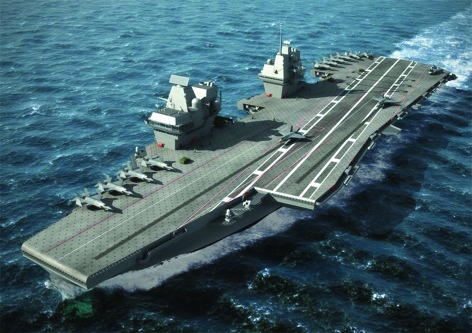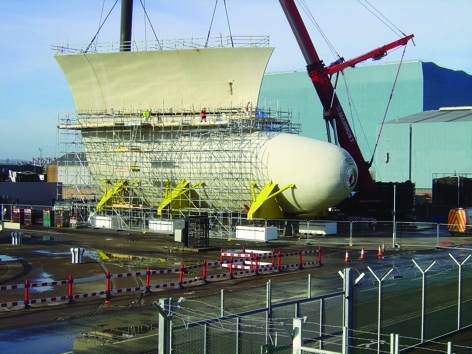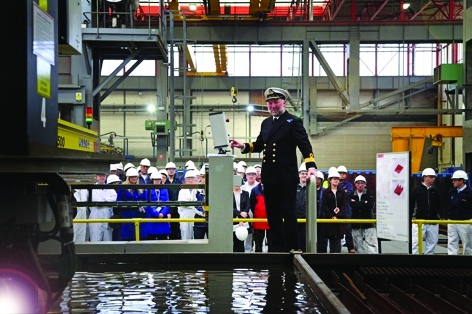I would like to start by wishing a Happy New Year to everyone who reads this.
A great deal has happened since my last blog, not least the announcement of the Strategic Defence and Security Review that work on the build of both the new aircraft carriers will continue. This is very good news for the Aircraft Carrier Alliance, the Royal Navy and the approximately 10,000 jobs in the UK which depend on the Carrier programme. The SDSR also announced that the UK will be procuring the more capable Carrier Variant (CV) of the F 35 aircraft instead of the Short Take-off and Vertical Landing (STOVL) version. This is, in my personal opinion, good news, but does result in alteration of the aircraft carrier design, which contains adaptability to accommodate the new aircraft launch system equipment, including catapults, jet blast deflectors and arrestor wires together with the associated below deck equipment and changes to the mission system.

While engineering the fitting of this equipment to the ships, the first of which is well into production, is no small challenge, our engineers and designers are already working hard to ensure that when we deliver the ships we will ultimately have the best and most capable solution.
Meanwhile the six shipyards working on production of the ships are continuing to press on with construction of Queen Elizabeth. The Lower Blocks are the massive sections that make up the hull of the ships and both Lower Blocks 03 at Govan and 02 in Portsmouth are now structurally complete up to four deck, the hangar deck, and three deck in the outboard areas. I can tell you it is a very long way down to the floor of the build hall from up there! When walking on the hangar deck being almost up amongst the crane rails gives a novel and different perspective to the build halls. At A&P Tyne the upper units of Centre Block 03 are structurally complete from the flight deck down to three deck, so virtually all the structure is built around the centre sections of the ship. On Valentine’s Day this year, the after ring of Lower Block 03 (LB03) will be moved around to align with the remainder of LB03 and combining together will commence, which is all proceeding towards shipping LB03 from Govan which will be the first block to enter the build dock in Rosyth later this year.

Combination of the two lower blocks making up the lower part of the bow of the ship is well advanced on the dock side at Rosyth and with the prominent bulbous bow this structure now resembles something like an enormous boot! The one remaining Lower Block, LB05, right at the aft end, and comprising the steering gear compartment and rudders, has commenced construction at Portsmouth recently, with the Commander of the Naval Base, Commodore Rob Thompson doing the honours and officially starting production. This lower block will be constructed and shipped to Rosyth in four units so that each is of a weight that will allow them to be lifted and lowered into the build dock by the Goliath Crane. The rudders themselves and the rudder horns and hull inserts have been constructed in Rosyth and are also now nearing completion.

The Goliath Crane for the build dock has been constructed in China and is currently on board a ship en route to Rosyth. As I write this the ship is in the Atlantic, heading north and is expected to arrive at Rosyth in late February. On arrival the ship will berth across the entrance to the build dock and then a very interesting transition will occur. The main beam of the crane will be jacked up, while it remains on the ship, the legs will be installed at each end and then the complete structure wheeled from the ship onto the crane rails by the dock. Installation of the Goliath Crane will be a highly visible indication of progress with the build of Queen Elizabeth and will make a significant difference to the Fife skyline. The crane will be commissioned during the spring and early summer months and will be used to install the first of the upper blocks onto the lowers before the end of the year.
2011 looks like being a very interesting year for the Aircraft Carrier Alliance and its suppliers, so to keep up to date with what is happening you may also wish to visit our website – www.aircraftcarrieralliance.co.uk











Water Sector Talent Exodus Could Cripple The Sector
Well let´s do a little experiment. My last (10.4.25) half-yearly water/waste water bill from Severn Trent was £98.29. How much does not-for-profit Dŵr...